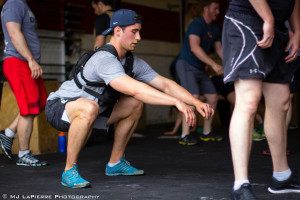
We’re firm believers in the idea that safety and performance are two sides of the same coin. The cues we give elite powerlifters and Games-bound CrossFitters are the same cues we give people trying to fix their nagging back pain or bum knee. Think of your body like a wrench. Could you use the wrench to beat a nail into a piece of wood? Probably. Will it prove to be extremely ineffective and, given enough improper nail beating repetitions, will it break? Probably. So when we use our bodies properly, just like a wrench, we’ll improve performance and longevity at the same time.
With that in mind. Here are three quick tip to improve your squat so that we can use our hips the way they are meant to.
Fix Your Feet
Everything starts with your feet. Your foot position has a tremendous impact upstream all the way to the hip. First and foremost, they dictate how much tension you can create in the hip. More tension in the hip = better squats. If you’re starting with your feet in a bad position, you’ve already given away huge potential and a lot of safety. Try this:
- Stand with your feet parallel to one another. Squeeze your butt. Now imagine trying to screw your femur (or upper leg bone) into the floor. If you do it right you should notice your knees pointing out diagonally instead of straight ahead. Notice how much tension you feel in your hips.
- Now turn your feet out as far as possible like a ballet dancer (duck footed). Squeeze your butt. Now imagine trying to screw your femur (or upper leg bone) into the floor. If you did it right, you shouldn’t get much of a change in your upper leg. Notice how much less tension you feel in your hips compared to when your feet were straight?
- Now for fun. Turn your feet toward each other (pigeon toed). Squeeze your butt. How’d that work out for you?
In general, you can turn your feet out about 12 degrees before you start rotating your shin and upper leg instead. Once those turn out, you’re asking for a stability disaster. So keep your feet within those 12 degrees and maintain that tension throughout the entire squat.
1 and ½ Squats
A lot of people are confused as to when the squat starts. At the very top right? You stand at the top of the squat, squeeze your butt, brace your abs, and screw your feet out, right? WRONG! The squat starts as soon as you’re under load. You’re under load as soon as you unrack the bar.
Treat taking the bar out of the rack as half a squat. You should be braced, tight and ready to go while the bar is weightless (aka in the rack). As soon as you walk the bar out of the rack it’s already too late. Trying to get tight under a heavy load is a surefire way to not get tight at all.
Finish Where You Start
Movement can be hard. Often times we equate movements to tunnels. It’s dark inside the tunnel and it can be really difficult to navigate especially when you’re newer at it. I think it’s much easier to think of the start of the movemtn (position A) and the end of the movement (position B) and don’t worry so much about the middle. Lucky for you, with the squat, those two are the same. All you need to do is brace and get as much tension as possible at the top. Then finish in the exact same one.
The most insidious violation of this rule is what I call the hip sway. You hear a lot “squeeze your butt at the top of the squat” but in reality this is wrong. You shouldn’t have to squeeze your butt, it should naturally be on at the top. When people think about squeezing their butt at the end of the squat that, by definition, means it wasn’t squeezed in the first place. This leads to people overextending at some point of the movement, then trying to “tuck their hips back under” at the top.
Instead, work on squeezing as hard as possible at the top and see if you can finish with that same amount of tension. If you can, it’s a good bet you maintained it throughout.
Conclusion
Squats can be as complex or as simple as you’d like. By no means exhaustive, this is just a simple list to help you be safer, and more effective whether you’re going for a world record or just trying to avoid pain.
